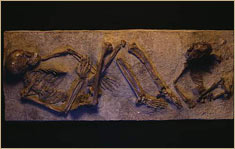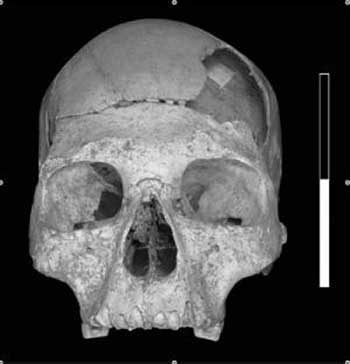Detecting ancient admixture and estimating demographic parameters in multiple human populations (pdf)
A rather odd looking pdf- runs a lot like a mini PowerPoint presentation, by the man who published the recent paper that concluded there probably was archaic admixture in humans. And yet again.. I see the 40k-60k OOA date in print. Grr.
Detecting ancient admixture and estimating demographic parameters in multiple human populations
We analyze patterns of genetic variation in extant human polymorphism data from the NIEHS SNPs project to estimate human demographic parameters. We update our previous work by considering a larger data set (more genes and more populations), and by explicitly estimating the amount of putative admixture between modern humans and archaic human groups (e.g., Neandertals, Homo erectus, H. floresiensis). We find evidence for this ancient admixture in European, East Asian and West African samples, suggesting that admixture between diverged hominin groups may be a general feature of recent human evolution.
Yet another DNA study that finds evidence of archaic contributions in modern human groups. Odd how these don’t make the news but anything that finds in favour of the OOA gets splattered all over the media.
We estimate admixture proportions of 14 % (95% CI: 8 – 20 %) in the European-American sample and 1.5% (95% CI: 0.5 – 2.5 %) in the East Asian sample. In both cases, the relative log-likelihood for a = 0 (i.e., no ancient admixture) is significantly lower than the maximum likelihood (likelihood-ratio test, p < 10-3) , which provides additional evidence (along with the S* results in the previous paragraph) that ancient admixture occurred. The estimates of admixture rates in Europeans are consistent with estimates of Neandertal admixture obtained from analyses of Neandertal DNA (Serre et al. 2004; Noonan et al. 2006), [. . .] Unlike previous studies, we incorporated admixture between archaic and modern humans as an additional demographic parameter to be co-estimated. Interestingly, we could exclude no admixture (i.e., exclude a = 0) in both of the non-African populations studied
The observation that all (three) populations studied seem to have evidence for ancient admixture suggests that ancient population structure may be a common feature of all contemporary human populations, and this ancient structure may predate the initial expansion of modern humans out of Africa.
Although some of the archaic DNA isn’t found in Africa, which would make the archaic admixture prior to the OOA hard to explain. This paper also finds evidence for archaic admixture in the Yoruba. I remember reading previously that the X chromosome showed signs of archaic ancestry in one pygmy group, so archaic ancestry in West Africa is supported by another paper. More detail… Testing for Archaic Hominin Admixture on the X Chromosome, which concluded the TMRCA was about 2 million years for one locus on the X chromosome and concludes..
For now, this locus represents a genealogical history that is most consistent with recent admixture from an archaic hominin population in Asia
Which is a far cry from Svante Paabo’s ‘no admixture but they were within the range of modern humans’ claim, which I found a bit odd. So you found they had essentially human DNA with us but decided they didn’t mingle …how?
I’d just like to comment that the OOA/RAR theory leaves absolutely NO room for any ancient DNA cropping in non Africans that doesn’t have a root in Africa- but it does, with remarkable frequency. In other words, the OOA doesn’t ‘fit’. That OOA is true of mostof our ancestry means sod all, it has to be true for all of it and it’s rather blatantly NOT the case, as there are a plethora of non-African but ancient in Eurasia mutations that invalidate it. Particularly the non African MC1R mutation ages that have ages of 100k-250k and a TMRCA of a million years.
Both African and non-African data suggest that the time to the most recent common ancestor is ª1 million years and that the age of the global 314 variant is 650,000 years. On this time scale, ages for the Eurasian distributed Val60Leu, Val92Met, and Arg163Gln variants are 250,000–100,000 years;
I’m going to have to make up a proper list of the DNA studies that find against the OOA theory.

![[j1.jpg]](https://i0.wp.com/4.bp.blogspot.com/_Ish7688voT0/SeXB1VtL0SI/AAAAAAAABPE/EIizGXM7HNQ/s1600/j1.jpg)
![[hohle_fels_figurine.jpg]](https://i0.wp.com/4.bp.blogspot.com/_Ish7688voT0/Sgs6mxf3DlI/AAAAAAAABdg/JJIgPRge8cs/s1600/hohle_fels_figurine.jpg)






 On the other hand; it has the brow ridges, heavy jaw and wider nose you typical of more archaic samples, as seen in this 26,000 year old ivory head from Europe. The average prognathism in the Paleolithic samples is greater than in modern populations, and probably has a lot to do with the much larger teeth humans had prior to the Neolithic farming revolution.
On the other hand; it has the brow ridges, heavy jaw and wider nose you typical of more archaic samples, as seen in this 26,000 year old ivory head from Europe. The average prognathism in the Paleolithic samples is greater than in modern populations, and probably has a lot to do with the much larger teeth humans had prior to the Neolithic farming revolution.